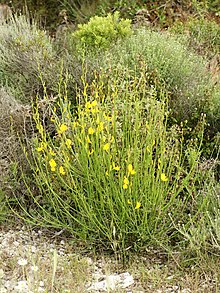Spartium
| Spartium | |
|---|---|

| |
| Scientific classification | |
| Kingdom: | Plantae |
| Clade: | Tracheophytes |
| Clade: | Angiosperms |
| Clade: | Eudicots |
| Clade: | Rosids |
| Order: | Fabales |
| Family: | Fabaceae |
| Subfamily: | Faboideae |
| Tribe: | Genisteae |
| Genus: | Spartium L. |
| Species: | S. junceum
|
| Binomial name | |
| Spartium junceum L.
| |
| Synonyms | |
|
Genus:
Species:
| |
Spartium junceum, known as Spanish broom,[1] rush broom, or weaver's broom,[2] it is a species of flowering plant in the family Fabaceae and the sole species in the genus Spartium.[3][4][5] It is closely related to the other brooms (in the genera Cytisus and Genista).
Description
Spartium junceum is a vigorous,
Taxonomy
The
Distribution and habitat
This species is
As an invasive species
Spartium junceum has been widely introduced into other areas, and is regarded as a noxious invasive species in places with a Mediterranean climate such as California and Oregon, Hawaii, central Chile, southeastern Australia,[10] the Western Cape in South Africa and the Canary Islands and Azores.[9][11] It was first introduced to California as an ornamental plant.[11][12]
Toxicity
Few cases have been described of intoxication by the S. junceum, including accidental ingestion of different parts of the plant by children.
Symptoms present depending on dose, method of exposure, and time elapsed since exposure; these include irritation of the oral and pharyngeal mucosa, hypersalivation, vomiting, stomach pain and diarrhea. In severe cases, neurological symptoms (such as midriasis, headaches, delirium and convulsions) may be present, as well as hypotension, bradycardia, and coma.[14]
Uses
The plant is used as an ornamental plant in gardens and in landscape plantings. It has gained the Royal Horticultural Society's Award of Garden Merit.[2][15]
In Bolivia and Peru, where it is known as retama,[9] (not to be confused with the genus Retama) and has become invasive in some areas. It is one of the most common ornamental plants, often seen growing along sidewalks in La Paz.[citation needed]
It has traditionally been used for the production of fiber, especially for tying vines. It is also used as a hedge because of its
Pharmacology
In work carried out on normoglycemic mice at the Faculty of Chemistry of the
Culture
Spartium junceum has made its way into the ethnobotany of the indigenous Aymara and Quechua cultures, in which it is believed to protect against evil, probably influenced by similar traditions of Hispanic origin.[citation needed] In Peru, it is known as retama, qarwash, inca pancara, talhui.[22]
The Peruvian huayno, Flor de Retama, written by Ricardo Dolorier in 1969, references the yellow flower and the Huanta massacre which occurred that year. Subsequently, all retama flowers were removed from the main plaza out of fear of government repression; today, the entrances to Huanta are planted with the flower.[23]
Known in Catalan as ginesta, it has often been regarded as the national flower of Catalonia, sometimes in combination with red poppies.[24]
Gallery
-
A stand of plants with many blooms, France
-
Flowers
-
Close-up of a flower
-
Mature fruit
References
- ^ NRCS. "Spartium junceum". PLANTS Database. United States Department of Agriculture (USDA). Retrieved 24 November 2015.
- ^ a b "RHS Plant Selector - Spartium junceum". Retrieved 14 February 2020.
- ^ "ILDIS LegumeWeb entry for Spartium". International Legume Database & Information Service. Cardiff School of Computer Science & Informatics. Retrieved 15 April 2014.
- USDA; ARS; National Genetic Resources Program. "GRIN species records of Spartium". Germplasm Resources Information Network—(GRIN) [Online Database]. National Germplasm Resources Laboratory, Beltsville, Maryland. Retrieved 15 April 2014.
- ^ "The Plant List entry for Spartium". The Plant List. Royal Botanic Gardens, Kew and the Missouri Botanical Garden. 2013. Retrieved 15 April 2014.
- ^ Jepson Manual Treatment
- ^ "A Modern Herbal | Broom, Spanish". www.botanical.com. Retrieved 2021-04-03.
- ISBN 978-1405332965.
- ^ a b c d "Spartium junceum". Germplasm Resources Information Network. Agricultural Research Service, United States Department of Agriculture. Retrieved 17 December 2017.
- ^ "The NSW Government WeedWise Resource from the Department of Primary Industries".
- ^ a b US Forest Service Fire Ecology
- ^ Element Stewardship: S. junceum
- ISSN 2341-2879.
- ^ PMID 24582126.
- ^ "AGM Plants - Ornamental" (PDF). Royal Horticultural Society. July 2017. p. 99. Retrieved 16 November 2018.
- ^ a b "FAO". Archived from the original on 2016-03-04. Retrieved 2010-08-13.
- ^ botanical.com
- OCLC 192083315.
- ^ Hipoglucemiantes -agentes : aloxano y plantas en general, acción hipoglucemiante de flor de retama (Saprtium junceum), Biblioteca-FQ, 1990, retrieved 2024-01-18
- PMID 10423862.
- PMID 10837986.
- OCLC 45860046.
- ^ Reynoso, Christian (2009-11-15). "Dolorier y la flor de Retama: pólvora y dinamita del corazón". Los Andes. Retrieved 2024-01-18.
- ^ (in Catalan) La ginesta, flor nacional de Catalunya




